Abstract
In the present study, the effects of perinatal exposure to Δ9-tetrahydrocannabinol (THC) on heroin-induced place conditioning and Fos-immunoreactivity (Fos-IR) were examined. Male albino Wistar rats (N=104) were pretreated with vehicle (n=52) or 5 mg/kg THC (n=52) from postnatal days 4 through 14. At approximately 8 weeks of age, 72 rats were divided into six equal groups (n=12 per group) and injected subcutaneously (s.c.) with vehicle, 0.5, or 2.0 mg/kg heroin and tested in an unbiased two-compartment place conditioning task. In vehicle-pretreated rats, 2.0 mg/kg but not 0.5 mg/kg heroin produced a significant place preference. Perinatal THC exposure significantly enhanced the rewarding properties of both doses of heroin. In the second experiment, 32 rats were divided into four equal groups (n=8 per group) and injected with vehicle or 0.5 mg/kg heroin s.c. and perfused 2-h later. Fos-IR was examined in several brain regions directly or indirectly involved in reward. Acute administration of heroin in vehicle pretreated rats increased Fos-IR in the central, medial, and dorsomedial caudate putamen (CPu), nucleus accumbens (NAC, core and shell regions), lateral septum, islands of Calleja-major (ICjM), bed nucleus of the stria terminalis (BNST), central nucleus of the amygdala (CEA), dorsolateral and dorsomedial periaqueductal gray (PAG), ventral tegmental area (VTA), Edinger–Westphal nucleus (EW). Perinatal THC exposure significantly increased heroin-induced Fos-IR in the dorsomedial CPu. Conversely, perinatal THC exposure reduced heroin-induced Fos-IR in the NAC (shell), BNST, CEA, dorsolateral and lateral PAG, VTA, and EW. The present study demonstrates an increase in the rewarding properties of heroin following exposure to THC at an early age and provides new evidence regarding possible neural correlates underlying this behavioral alteration.
Similar content being viewed by others
Log in or create a free account to read this content
Gain free access to this article, as well as selected content from this journal and more on nature.com
or
References
Alheid GF, Heimer L (1988). New perspectives in basal forebrain organization of special relevance for neuropsychiatric disorders: the striatopallidal, amygdaloid, and corticopetal components of substantia innominata. Neuroscience 27: 1939.
Arnold JC, Topple AN, Hunt GE, McGregor IS (1998). Effects of pre-exposure and co-administration of the cannabinoid receptor agonist CP 55940 on behavioural sensitization to cocaine. Eur J Pharmacol 354: 9–16.
Aston-Jones G, Delfs JM, Druhan J, Zhu Y (1999). The bed nucleus of the stria terminalis. A target site for noradrenergic actions in opiate withdrawal. Ann NY Acad Sci 877: 486–498.
Bachtell RK, Weitemier AZ, Galvan-Rosas A, Tsivkovskaia NO, Risinger FO, Phillips TJ et al (2003). The Edinger–Westphal-lateral septum urocortin pathway and its relationship to alcohol consumption. J Neurosci 23: 2477–2487.
Brown LL, Smith DM, Goldbloom LM (1998). Organizing principles of cortical integration in the rat neostriatum: corticostriate map of the body surface is an ordered lattice of curved laminae and radial points. J Comp Neurol 392: 468–488.
Browne RG, Segal DS (1980). Behavioral activating effects of opiates and opioid peptides. Biol Psychiatry 15: 77–86.
Cadoni C, Pisanu A, Solinas M, Acquas E, Di Chiara G (2001). Behavioural sensitization after repeated exposure to Δ9-tetrahydrocannabinol and cross-sensitization with morphine. Psychopharmacology (Berl) 158: 259–266.
Calenco-Choukroun G, Dauge V, Gacel G, Feger J, Roques BP (1991). Opioid delta agonists and endogenous enkephalins induce different emotional reactivity than mu agonists after injection in the rat ventral tegmental area. Psychopharmacology (Berl) 103: 493–502.
Cole JC, Sumnall HR, O’Shea E, Marsden CA (2003). Effects of MDMA exposure on the conditioned place preference produced by other drugs of abuse. Psychopharmacology (Berl) 166: 383–390.
Corchero J, García L, Manzanares J, Fernández-Ruiz JJ, Fuentes JA, Ramos JA (1998). Perinatal Δ9-tetrahydrocannabinol exposure reduces proenkephalin gene expression in the caudate-putamen of adult female rats. Life Sci 63: 843–850.
Davis M (1998). Are different parts of the extended amygdala involved in fear versus anxiety? Biol Psychiatry 44: 1239–1247.
D’Este L, Scontrini A, Casini A, Pontieri FE, Renda TG (2002). Heroin sensitization as mapped by c-Fos immunoreactivity in the rat striatum. Brain Res 933: 144–149.
Ebrahim SH, Gfroerer J (2003). Pregnancy-related substance use in the United States during 1996–1998. Obstet Gynecol 101: 374–379.
Erb S, Salmaso N, Rodaros D, Stewart J (2001). A role for the CRF-containing pathway from central nucleus of the amygdala to bed nucleus of the stria terminalis in the stress-induced reinstatement of cocaine seeking in rats. Psychopharmacology (Berl) 158: 360–365.
Erdtmann-Vourliotis M, Mayer P, Riechert U, Hollt V (2000). Prior experience of morphine application alters the c-Fos response to MDMA (‘ecstasy’) and cocaine in the rat striatum. Mol Brain Res 77: 55–64.
Fernandez-Ruiz JJ, Berrendero F, Hernandez ML, Ramos JA (2000). The endogenous cannabinoid system and brain development. Trends Neurosci 23: 14–20.
Fernandez-Ruiz JJ, Berrendero F, Hernandez ML, Romero J, Ramos JA (1999). Role of endocannabinoids in brain development. Life Sci 65: 725–736.
Fink JS, Smith GP (1980). Mesolimbicocortical dopamine terminal fields are necessary for normal locomotor and investigatory exploration in rats. Brain Res 199: 359–384.
Fried PA (1982). Marihuana use by pregnant women and effects on offspring: An update. Neurobehav Toxicol Teratol 4: 451–454.
Fried PA, Makin JE (1987). Neonatal behavioural correlates of prenatal exposure to marihuana, cigarettes and alcohol in a low risk population. Neurotoxicol Teratol 9: 1–7.
Fried PA, Watkinson B, Gray R (1999). Growth from birth to early adolescence in offspring prenatally exposed to cigarettes and marijuana. Neurotoxicol Teratol 21: 513–525.
Fudge JL, Haber SN (2001). Bed nucleus of the stria terminalis and extended amygdala inputs to dopamine subpopulations in primates. Neuroscience 104: 807–827.
García-Gil L, de Miguel R, Ramos JA, Fernández-Ruiz JJ (1996). Perinatal Δ9-tetrahydrocannabinol exposure in rats modifies the responsiveness of midbrain dopaminergic neurons in adulthood to a variety of challenges with dopaminergic drugs. Drug Alcohol Depend 42: 155–166.
Georges F, Aston-Jones G (2001). Potent regulation of midbrain dopamine neurons by the bed nucleus of the stria terminalis. J Neurosci 21: RC160 (1–6).
Georges F, Aston-Jones G (2002). Activation of ventral tegmental area cells by the bed nucleus of the stria terminalis: a novel excitatory amino acid input to midbrain dopamine neurons. J Neurosci 22: 5173–5187.
Grabus SD, Glowa JR, Riley AL (2004). Morphine- and cocaine-induced c-Fos levels in Lewis and Fischer rat strains. Brain Res 998: 20–28.
Hall W, Solowij N (1998). Adverse effects of cannabis. Lancet 352: 1611–1616.
Hall WD, Carless JM, Homel PJ, Flaherty BJ, Reilly CJ (1991). The characteristics of cocaine users among young adults in Sydney. Med J Aust 155: 11–14.
Hand TH, Stinus L, Le Moal M (1989). Differential mechanisms in the acquisition and expression of heroin-induced place preference. Psychopharmacology (Berl) 98: 61–67.
Kamenetsky S, Rabinowitz R, Urca G, Korczyn AD (1997). Neuroanatomical aspects of mydriatic action of morphine in rats. J Ocul Pharmacol Ther 13: 405–413.
Koob GF (1992). Drugs of abuse: anatomy, pharmacology and function of reward pathways. Trends Pharmacol Sci 13: 177–184.
Krettek JE, Price JL (1978). Amygdaloid projections to subcortical structures within the basal forebrain and brainstem in the rat and cat. J Comp Neurol 178: 225–254.
Lamarque S, Taghzouti K, Simon H (2001). Chronic treatment with Δ9-tetrahydrocannabinol enhances the locomotor response to amphetamine and heroin. Implications for vulnerability to drug addiction. Neuropharmacology 41: 118–129.
Leri F, Flores J, Rodaros D, Stewart J (2002). Blockade of stress-induced but not cocaine-induced reinstatement by infusion of noradrenergic antagonists into the bed nucleus of the stria terminalis or the central nucleus of the amygdala. J Neurosci 22: 5713–5718.
Meng ZH, Feldpaush DL, Merchant KM (1998). Clozapine and haloperidol block the induction of behavioral sensitization to amphetamine and associated genomic responses in rats. Mol Brain Res 61: 39–50.
Meyer JS, Kunkle R (1999). Behavioral responses to a D1 dopamine agonist in weanling rats treated neonatally with cocaine and Δ9-tetrahydrocannabinol. Neurotoxicol Teratol 21: 375–380.
Meyer ME, McLaurin BI, Meyer ME (1995). DALDA (H-Tyr-D-Arg-Phe-Lys-NH2), a potent μ-opioid peptide agonist, affects various patterns of locomotor activities. Pharmacol Biochem Behav 51: 149–151.
Miller NS, Klahr AL, Gold MS, Sweeney K, Cocores JA, Sweeney DR (1990). Cannabis diagnosis of patients receiving treatment for cocaine dependence. J Subst Abuse 2: 107–111.
Mucha RF, van der Kooy D, O’Shaughnessy M, Bucenieks P (1982). Drug reinforcement studied by the use of place conditioning in rat. Brain Res 243: 91–105.
Navarro M, de Miguel R, de Fonseca FR, Ramos JA, Fernandez-Ruiz JJ (1996). Perinatal cannabinoid exposure modifies the sociosexual approach behavior and the mesolimbic dopaminergic activity of adult male rats. Behav Brain Res 75: 91–98.
Navarro M, Rodriguez de Fonseca F, Hernandez ML, Ramos JA, Fernandez-Ruiz JJ (1994). Motor behavior and nigrostriatal dopaminergic activity in adult rats perinatally exposed to cannabinoids. Pharmacol Biochem Behav 47: 47–58.
Norwood CS, Cornish JL, Mallet PE, McGregor IS (2003). Pre-exposure to the cannabinoid receptor agonist CP 55940 enhances morphine behavioral sensitization and alters morphine self-administration in Lewis rats. Eur J Pharmacol 465: 105–114.
Paxinos G, Watson C (1998). The Rat Brain in Stereotaxic Coordinates. Academic Press: New York.
Pontieri FE, Monnazzi P, Scontrini A, Buttarelli FR, Patacchioli FR (2001a). Behavioral sensitization to heroin by cannabinoid pretreatment in the rat. Eur J Pharmacol 421: R1–R3.
Pontieri FE, Monnazzi P, Scontrini A, Buttarelli FR, Patacchioli FR (2001b). Behavioral sensitization to WIN55212-2 in rats pretreated with heroin. Brain Res 898: 178–180.
Rubio P, de Fonseca FR, Martin-Calderon JL, Del Arco I, Bartolome S, Villanua MA et al (1998). Maternal exposure to low doses of Δ9-tetrahydrocannabinol facilitates morphine-induced place conditioning in adult male offspring. Pharmacol Biochem Behav 61: 229–238.
Shu SY, Ju G, Fan LZ (1988). The glucose oxidase-DAB-nickel method in peroxidase histochemistry of the nervous system. Neurosci Lett 85: 169–171.
Singh ME, Warty NA, McGregor IS, Mallet PE (2002). Repeated exposure to a cannabinoid receptor agonist alters subsequent basal and morphine-induced Fos immunoreactivity. 32st Annual Meeting of the Society for Neuroscience, Orlando, FL, USA.
Solinas M, Panlilio LV, Goldberg SR (2004). Exposure to Δ9-tetrahydrocannabinol (THC) increases subsequent heroin taking but not heroin's reinforcing efficacy: a self-administration study in rats. Neuropsychopharmacology 29: 1301–1311.
Thornton SR, Compton DR, Smith FL (1998). Ontogeny of μ opioid agonist anti-nociception in postnatal rats. Dev Brain Res 105: 269–276.
Turgeon SM, Pollack AE, Fink JS (1997). Enhanced CREB phosphorylation and changes in c-Fos and FRA expression in striatum accompany amphetamine sensitization. Brain Res 749: 120–126.
Tzschentke TM (1998). Measuring reward with the conditioned place preference paradigm: a comprehensive review of drug effects, recent progress and new issues. Prog Neurobiol 56: 613–672.
Vacca G, Serra S, Brunetti G, Carai MAM, Gessa GL, Colombo G (2002). Boosting effect of morphine on alcohol drinking is suppressed not only by naloxone but also by the cannabinoid CB1 receptor antagonist, SR 141716. Eur J Pharmacol 445: 55–59.
Vela G, Martin S, Garcia-Gil L, Crespo JA, Ruiz-Gayo M, Fernandez-Ruiz JJ et al (1998). Maternal exposure to Δ9-tetrahydrocannabinol facilitates morphine self-administration behavior and changes regional binding to central μ opioid receptors in adult offspring female rats. Brain Res 807: 101–109.
Warty NA, Singh ME, McGregor IS, Mallet PE (2002). Cannabinoid receptor antagonist modulatioin of morphine-induced Fos expression in feeding-related brain regions. 32nd Annual Meeting of the Society for Neuroscience, Orlando, FL, USA.
Wenger T, Moldrich G, Furst S (2003). Neuromorphological background of cannabis addiction. Brain Res Bull 61: 125–128.
Zuckerman B, Frank DA, Hingson R, Amaro H, Levenson SM, Kayne H et al (1989). Effects of maternal marijuana and cocaine use on fetal growth. N Engl J Med 320: 762–768.
Acknowledgements
This study was supported by a grant from the Australian Research Council to ISM and PEM. MES's studies were supported by an Australian Postgraduate Award. We would like to thank Dr Ian Price for comments on an earlier draft of the manuscript. We would also like to thank June Young, Aaron Verty, and Melanie O’Shea for technical assistance.
Author information
Authors and Affiliations
Corresponding author
Rights and permissions
About this article
Cite this article
Singh, M., McGregor, I. & Mallet, P. Perinatal Exposure to Δ9-Tetrahydrocannabinol Alters Heroin-Induced Place Conditioning and Fos-Immunoreactivity. Neuropsychopharmacol 31, 58–69 (2006). https://doi.org/10.1038/sj.npp.1300770
Received:
Revised:
Accepted:
Published:
Issue date:
DOI: https://doi.org/10.1038/sj.npp.1300770
Keywords
This article is cited by
-
Characterization of cannabinoid plasma concentration, maternal health, and cytokine levels in a rat model of prenatal Cannabis smoke exposure
Scientific Reports (2023)
-
Neurons expressing the aryl hydrocarbon receptor in the locus coeruleus and island of Calleja major are novel targets of dioxin in the mouse brain
Histochemistry and Cell Biology (2021)
-
Preclinical Studies of Cannabinoid Reward, Treatments for Cannabis Use Disorder, and Addiction-Related Effects of Cannabinoid Exposure
Neuropsychopharmacology (2018)
-
Repeated administration of a synthetic cannabinoid receptor agonist differentially affects cortical and accumbal neuronal morphology in adolescent and adult rats
Brain Structure and Function (2016)
-
Developmental consequences of perinatal cannabis exposure: behavioral and neuroendocrine effects in adult rodents
Psychopharmacology (2011)



